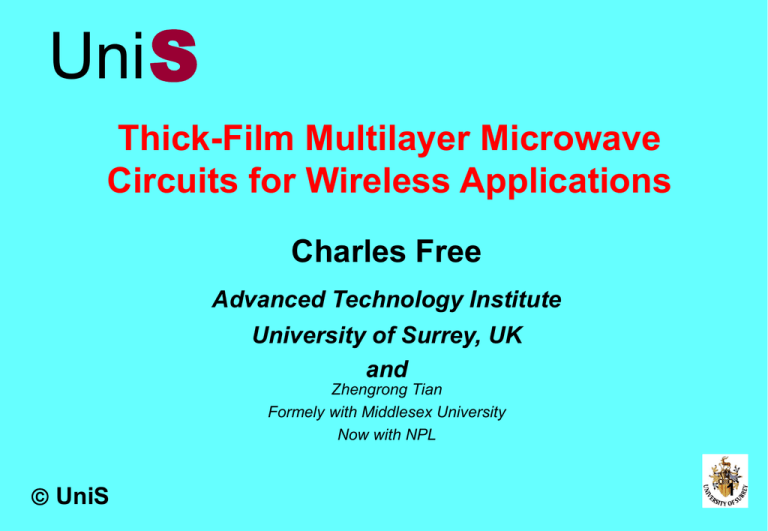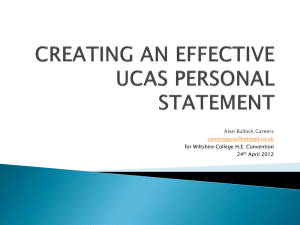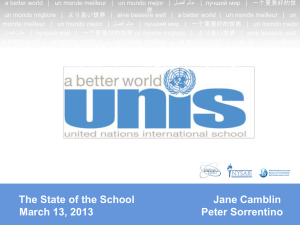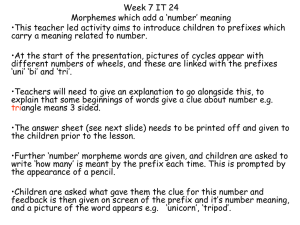S UniS - WordPress.com
advertisement

Uni S Thick-Film Multilayer Microwave Circuits for Wireless Applications Charles Free Advanced Technology Institute University of Surrey, UK and Zhengrong Tian Formely with Middlesex University Now with NPL UniS 1 Uni S University of Surrey Located in Guildford 30km south of London Approx. 5000 students Single campus - lot of student accommodation on-site Technological university Research-led university Top of UK research ratings in Electronic Engineering UniS Uni S School of Electronics: Research Groups Surrey Space Centre Small satellites: design + construction + control Advanced Technology Institute Semiconductors + ion beam applications + microwave systems Centre for Communication Systems Research Mobile + satellite communications Centre for Vision, Speech and Signal Processing Medical + Multimedia + Robotics UniS Uni S Advanced Technology Institute Microwave Systems: - MMIC design - RF and Microwave MCMs - Microwave circuits and antennas - thick-film (including photoimageable) processing - access to clean rooms (class 1000 and class 100) - measurement capability to 220GHz UniS Uni S Thick-Film Multilayer Microwave Circuits for Wireless Applications UniS Uni S CONTENTS Introduction Thick-film technology Significance of line losses Single layer microwave circuits Multilayer microwave circuits Summary UniS 3 Uni S INTRODUCTON UniS Uni S Typical frequencies for wireless applications: Current mobile: 0.9GHz - 2GHz 3G systems: 2.5GHz Bluetooth: 2.5GHz GPS: 12.6GHz LMDS: 24GHz and 40GHz Automotive: 77GHz UniS Uni S Driving forces created by the wireless market: lower cost higher performance greater functionality increased packing density UniS Uni S Microstrip: basic microwave interconnection structure UniS Uni S Summary of key material requirements at RF: Conductors:- low bulk resistivity - good surface finish (low surface roughness) - high line/space resolution - good temperature stability Dielectrics: - low loss tangent (<10-2) - good surface finish - precisely defined r (stable with frequency) - isotropic r - consistent substrate thickness - low Tf (< 50 ppm/oC) 28 UniS Uni S RF Transceiver Architecture UniS Uni S Features of an RF MCM UniS 9 Uni S THICK-FILM TECHNOLOGY UniS Uni S Thick-Film Technology Advantages: Low Cost Feasibility for mass production Adequate quality at microwave frequencies Potential for multi-layer circuit structures Difficulty: Fabrication of fine line and gaps: limited quality by direct screen printing UniS Uni S Standard range of materials is used: CONDUCTORS: - gold - silver - copper DIELECTRICS: - ceramic (alumina) - green tape (LTCC) - thick-film pastes - laminates Plus photoimageable conductors and dielectrics UniS 23 Uni S Fine lines < 25 micron with 1 micron precision High density, 4 micron thick conductor High conductivity - 95% of bulk 96% Al 50m lines UniS Photodefined conductors Uni S MICROSTRIP RESONANT RING TEST STRUCTURE r2 W W r1 S UniS S Uni S Microstrip Resonant Ring • can be used to measure total line loss and vp (measure Q loss, measure fo vp ) • does not separate conductor and dielectric loss • ring is loaded by input and output ports - source of measurement error UniS Uni S Meander-line test structure • can be used to measure total line loss and vp (measure Q loss, measure fo vp ) • does not separate conductor and dielectric loss • ring is loaded by input and output ports - source of measurement error UniS Uni S Chamfering of the corners is a necessary precaution in microstrip to avoid reflections UniS Uni S 0.04 0.035 Line Loss (dB/mm) 0.03 0.025 0.02 0.015 0.01 0.005 0 0 5 10 15 20 25 30 35 40 45 Frequency (GHz) measured simulated Comparison of measured and simulated loss in a 50 line fabricated on 99.6% alumina. [substrate thickness = 254m and line width = 255m] UniS Uni S 0.3 Line Loss (dB/wavelength) 0.25 0.2 0.15 0.1 0.05 0 4 8 12 16 20 24 28 32 36 40 44 Frequency (GHz) Measured line loss: 50 thick-film microstrip line UniS Uni S 0.04 III 0.035 Line Loss (dB/mm) 0.03 0.025 C II B I 0.02 0.015 A 0.01 0.005 0 4 8 12 16 20 24 28 32 36 40 44 Frequency (GHz) Typical microstrip line losses UniS 29 Uni S Skin effect: at RF and microwave frequencies current tends to flow only in the surface of a conductor Skin depth (): depth of penetration at which the magnitude of the current has decreased to 1/e of the surface value 1 f Significance: surface of conductors must be smooth and the edges well defined to minimise losses UniS 27 Uni S 0.045 RGH=0.5 0.04 Line loss (dB/mm) 0.035 0.03 RGH=0.2 0.025 RGH=0.1 RGH=0 0.02 0.015 0.01 0.005 0 0 10 20 30 40 50 Frequency (GHz) Effect of surface roughness on the loss in a microstrip line UniS 30 Uni S Effect of loss tangent on line loss UniS 31 Uni S 100% 80% Line Loss (%) 60% 40% 20% 0% 8 20 32 44 Frequency (GHz) Bulk Conductor Loss UniS Loss due to Surface Roughness Dielectric Loss 32 Uni S 100% 90% 80% 70% L in e L o ss (% ) 60% 50% 40% 30% 20% 10% 0% Al LTC C D iffe re n t M a te ria l (e va lu a te d a t 2 G H z) B u lk C o n d u cto r L o ss UniS L o ss d u e to S u rfa ce R o u g h n e ss D ie le ctric L o ss 33 Uni S LTCC TECHNOLOGY • • LTCC technology is a well-established technology Reliability established in the automotive market Advantages for high frequency applications: • UniS parallel processing (→ high yield, fast turnaround, reduced cost) • precisely defined parameters • high performance conductors • potential for multi-layer structures • high interconnect density Uni S LTCC TECHNOLOGY Microwave applications: LTCC can meet the physical and electrical performance demanded at frequencies above 1GHz Increases in material and circuit production are reflected in lower costs: LTCC is now comparable to FR4 Significant space savings when compared to other technologies, such as FR4 UniS Uni S SIGNIFICANCE OF LINE LOSSES UniS Uni S MICROWAVE RECEIVER Feeder BPF1 LNA BPF2 Mixer Schematic of front-end of a microwave receiver UniS Uni S RECEIVER NOISE PERFORMANCE Feeder LNA BPF1 BPF2 Mixer Tm System noise temperature (Tsys) T sys T feeder UniS T BPF 1 G feeder T pa G feeder G BPF 1 T BPF 2 G feeder G pa G BPF 2 G feeder G BPF 1G pa G BPF 2 ........ Uni S RECEIVER NOISE PERFORMANCE T sys T feeder T BPF 1 G feeder T pa G feeder G BPF 1 T BPF G feeder G pa G BPF Tm 2 2 G feeder G BPF 1G pa G BPF Significance of expression for Tsys: ........ 2 • noise performance dominated by first stage • a lossy first stage introduces noise: Tfeeder = (L -1) 290 • a lossy first stage magnified noise from succeeding stages: Gfeeder < 1 UniS Uni S Dielectric Properties @ 9GHz UniS Material r Tan x 10-3 99.5% AL 9.98 0.1 LTCC1 7.33 3.0 LTCC2 6.27 0.4 LTCC3 7.2 0.6 LTCC4 7.44 1.2 LTCC5 6.84 1.3 LTCC6 8.89 1.4 Published material data Uni S CALCULATED RESULTS Feeder LNA BPF1 Noise figure variation BPF2 Mixer 12 10 8 6 4 2 ta n d = 0 .0 0 5 ta n d = 0 .0 0 1 ta n d = 0 .0 0 0 1 0 1 UniS 2 3 4 5 Uni S SINGLE-LAYER MICROWAVE CIRCUITS UniS Uni S Single-layer microstrip circuits: all conductors in a single layer coupling between conductors achieved through edge or end proximity (across narrow gaps) Problem: difficult to fabricate (cheaply in production) fine gaps, possibly 10m UniS Uni S End-coupled filter Directional coupler Examples of single-layer microstrip circuits UniS Uni S DC break Edge-coupled filter Examples of single-layer microstrip circuits UniS Uni S MULTI-LAYER MICROWAVE CIRCUITS UniS Uni S Multilayer microwave circuits: conductors stacked on different layers conductors separated by dielectric layers allows for (strong) broadside coupling eliminated need for fine gaps registration between layers not as difficult to achieve as narrow gaps technique well-suited to thick-film print technology also suitable for LTCC technology UniS Uni S Direct port 4 3 Isolated port l Thick-film dielectric layer Multilayer configuration W2 Main substrate εr1 h1 εr H S W1 Ground plane Input port 1 2 Coupled port UniS Uni S Thick-film technology is particularly suitable for the implementation of multilayer circuits: higher packing density integration of antenna close coupling between conductors Circuit examples: UniS DC block Directional coupler Uni S Directional Coupler Multilayer Concept Single Layer Structure UniS Uni S 2dB Directional Coupler - Measured Results 0 -5 -1 0 -1 5 -2 0 -2 5 -3 0 -3 5 0 1 2 3 4 5 6 7 8 F re q u e n c y (G H z ) UniS 9 10 11 Uni S 3dB Directional Coupler - Measured Results 0 -1 0 -2 0 -3 0 -4 0 -5 0 0 2 4 6 8 10 12 F re q u e n c y (G H z ) UniS 14 16 18 20 Uni S /4 Microstrip DC block UniS Uni S Multilayer DC block 380um r = 3.9 Alumina UniS 180um 300um Uni S 2 VSW R 1 .8 1 .6 1 .4 1 .2 1 1 2 3 4 5 6 7 8 9 10 11 12 F re q u e n cy (G H z) Measured performance of multilayer DC block UniS Uni S In s e rtio n L o s s (d B ) 2 1 .6 1 .2 0 .8 0 .4 0 1 2 3 4 5 6 7 8 9 10 11 12 F re q u e n cy (G H z) Measured performance of multilayer DC block UniS Uni S SUMMARY UniS Uni S SUMMARY: Thick-film technology provides a viable fabrication process for wireless circuits at microwave frequencies Multilayer microwave circuits can offer enhanced performance for coupled-line circuits Photoimageable thick-film materials extend the usable frequency range to mm-wavelengths UniS Uni S C.Free@surrey.ac.uk www.ee.surrey.ac.uk www.ee.surrey.ac.uk/ati UniS






